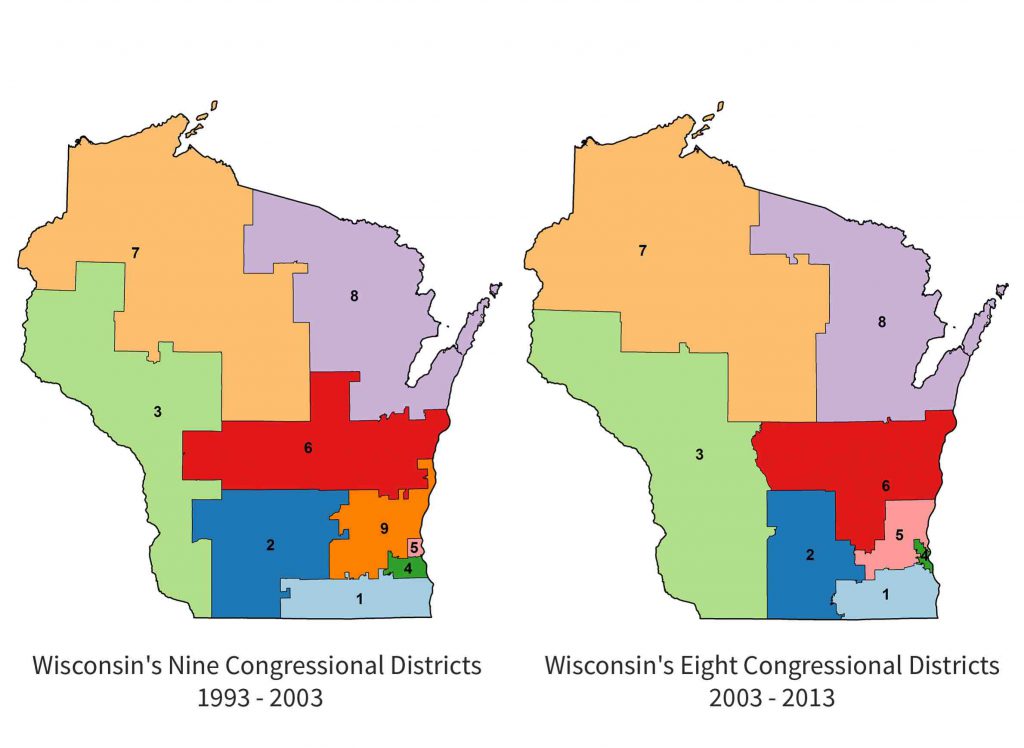Please Submit Maps to Legislature
Vos has welcomed this, apparently fearing he’d look bad for overtly opposing non-partisan redistricting.

File image showing the evolution of Wisconsin’s congressional districts. Image by the UW Applied Population Laboratory.
Speaker Robin Vos has invited Wisconsinites to submit maps to the Legislature, and we all should take him up on that invitation.
The more maps that citizen activists submit, the more pressure there will be on the Legislature not to rig the maps.
The first group is the activist community — all of us — that have raised the issue of nonpartisan redistricting to new heights over the last few years, demanding transparency and public participation.
And the second group is the People’s Maps Commission, which has been a model of transparency and a model for bringing the public into the process. (Thanks to many of you, it received more than 800 maps from citizens this summer.)
Fearing he’d look bad by not mimicking the People’s Maps Commission, Vos has provided us with a website “to provide input on the 2021 redistricting process.” The website says you can “create a full statewide plan,” “create a regional plan,” or “identify a community of interest.”
If you already submitted a map to the People’s Maps Commission, you can upload that one to the Legislature’s website.
And if you haven’t submitted one yet, the website offers you some handy software programs that you can use to create your map.
And don’t feel penned in by a couple of the criteria the Legislature offers for drawing the maps, as they seem to be trying to stack the deck in favor of the rigged lines from 2011.
You will, of course, need to create a map that has roughly the same number of people in each district. That’s a legal requirement.
But you don’t need to worry about “core constituency,” one of the criteria the Legislature lists.
It defines this as “the measure of how many people will stay in the same district after the enactment of the new districts.” But since the old districts were rigged in one of the worst gerrymanders in modern American history, according to a ruling in the federal court, those lines should not weigh heavily on you as you draw your map.
And you don’t have to worry about “staggered term disenfranchisement,” a phrase I’d never heard of before. The website says it “refers to people who did not vote for State Senator in 2020 and would not get to vote for State Senator in 2022. During this redistricting cycle, this occurs when a voter is “moved” from an odd-numbered district under the old plan to an even-numbered district under a new plan.”
Any redistricting runs a risk that a small number of voters may fall into this category, but by stressing this criteria, the Legislature is again showing its preference for clinging to the rigged maps of 2011.
Then the ball will be in Vos’s court.
It’s one thing to solicit citizen input, which is a good thing in and of itself. But it’s another thing, and an even better thing, to take that citizen input into account when you are doing the actual drawing of the new maps.
Vos has solicited the input, so let’s provide it.
And then let’s call his bluff if he doesn’t use it.
Matt Rothschild is the executive director of the Wisconsin Democracy Campaign.
Op-Ed
-
Wisconsin Candidates Decry Money in Politics, Plan to Raise Tons of It
 Dec 15th, 2025 by Ruth Conniff
Dec 15th, 2025 by Ruth Conniff
-
Trump Left Contraceptives to Rot; Women Pay the Price
 Dec 8th, 2025 by Dr. Shefaali Sharma
Dec 8th, 2025 by Dr. Shefaali Sharma
-
Why the Common Council’s Amended Budget is Good Policy for Milwaukee
 Nov 20th, 2025 by Alds. Marina Dimitrijevic and Russell W. Stamper, II
Nov 20th, 2025 by Alds. Marina Dimitrijevic and Russell W. Stamper, II






















I’m all for soliciting the public’s input on the maps. However I would point out that republican’s in Florida did this same thing a few years back – there is a PBS documentary from a few years ago. The “public submission” was a smoke screen used so that partisan maps could be proposed by those in cahoots with a strikingly partisan intent. Republicans on the committee were able to say “these came from the public, not us…” It took a significant amount of investigation, and an unrelated law suit, for this conspiracy to be revealed, but by then it was too late.